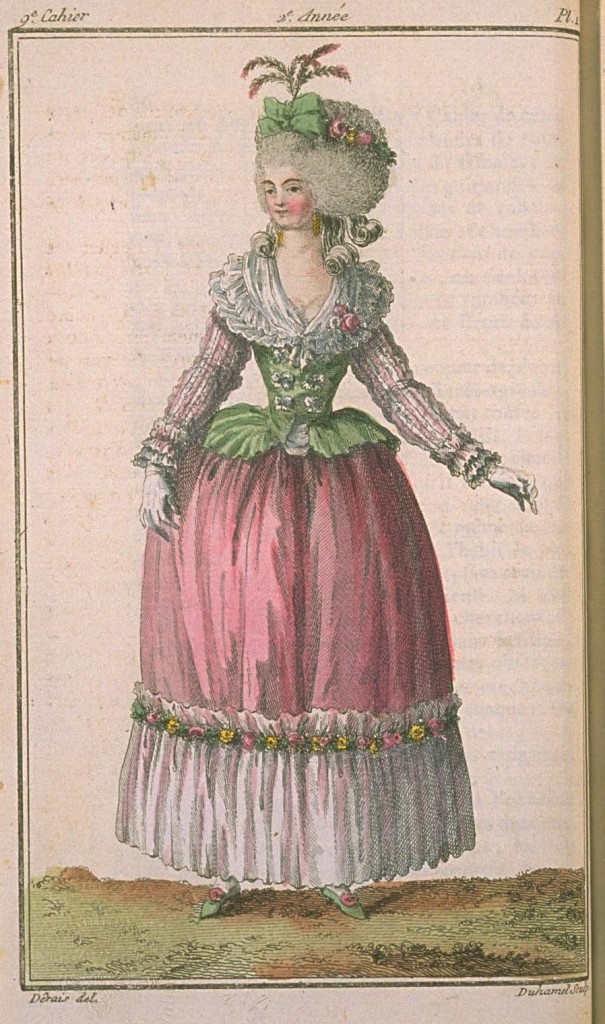
DESPITE the details that we gave in the preceding Issue on all the forms of caracos, of justes, of Turkish caracos, of little jackets, all has not yet been said. It is true that Fashion has made progress since the last Issue. It has adorned, it has embellished, so to speak, the simplicity of these ball costumes that we had the pleasure of renting. It has not added very great decoration, but it has added enough to make a difference. it is to the caracos, it is to the petticoats principally that more has been added; it is these which have been made to stand out. How? With crepe or gauze sleeves, pleated in large folds, and of diverse colors, attached to caracos, justes, little jackets; with artificial bouquets, places at intervals in the top of the petticoat flounces (there’s no doubt that this fashion is due to the first English Print of the fourth Issue of this second Year); with garlands of artificial roses, attached over the flounces and falling over it in swags; with garlands of ribbons, also attached over the flounces and also falling over them in swags; with bouillons of gauze or crepe of diverse colors, which are interlaced with artificial flowers, fastened and falling in swags, like the garlands of flowers and ribbons.
This variation cannot fail to please, and to give a very agreeable look at a ball, in shading, in perfectly combining all the colors of the costumes of the different dancers. One must believe that it is overall the bright brilliance that each wants to find at a ball, since it is known that each woman can, forgetting her rank in society, her state, her birth, and even her fortune, appear at a ball in the richest, most elegant, most beautiful dress, without fearing to encourage a very serious critique. If men seek and require the attention to please from women at balls, if it is this attention that women observe by the means of this agreed-upon elegance, granted by everyone, so much the better; each thing follows its law, and nature takes its course, independently of opinions, vulgar ideas, or prejudices.
It should not be expected of us on the occasion of balls, that we will publish ballets, minuets, dances, new or fashionable country dances: other than our hearing about it, if we would not give them all in figures, other than it being necessary to fill fifty pages of lone figures, or at least descriptions of figures, and other than us encroaching on the privileges of dancing Masters, and Music Sellers, to whom we would never wish more harm than any other person, it is that this announcement is not our district. Speaking of ball dress, that is our mission, that is our law. To go further, we would pass the place where we should stop ourselves.
But for us to speak of what does not concern us, to arrogate to ourselves the rights that can be claimed of us, no. We know too well our obligations, and we have very good reasons for not branching out.
To get into the subject, and speak of new ball dresses; the Woman represented in the FIRST PLATE is dressed in an apple green satin caraco, cut across the middle of the waist, as men’s suits were, two years ago, in such a manner as to allow the bottom of the stomacher or waistcoat made of white satin to be seen. Six white rosettes of satin ribbon trim the caraco’s fronts. The sleeves of this caraco are of white gauze, pleated, showing a pink layer below. At the ends, there are pinked ruffles of white gauze, in two rows.
The Woman is also dressed in a pink satin petticoat, trimmed with a very long flounce of white gauze, trimmed with a garland of artificial roses.
She is coiffed entirely en cheveux, with little separate curls, only having a bouquet of artificial roses on her head, falling on the right, a dark green satin ribbon bow, and an aigrette of black rooster feathers with flame-colored points. Two fat curls on each side fall on her chest. Her hair, in the back, is tied in a very thick cadogan, with a reversed curl.
One would not say that Fashion, in increasing petticoats and caracos, in decorating them further, wanted to simplify the hair, so as to make a fair equilibrium in expenses? One may not fear being too little dressed with this simple coiffure. A young person we adore appeared, several days ago, in this dress; she seemed superb to us.
On her neck, a fichu-jabot d’homme and with two collars. This new type of fichu, which uncovers a little of women’s chests, is replacing fichu-chemises and making them disappear, though the latter lasted a long time.
On her feet, apple green satin shoes, flounced with white satin ribbon.
Her hands are covered with white leather gloves.
We have represented her positioned to dance a minuet. This attitude gives a very beautiful expression.

